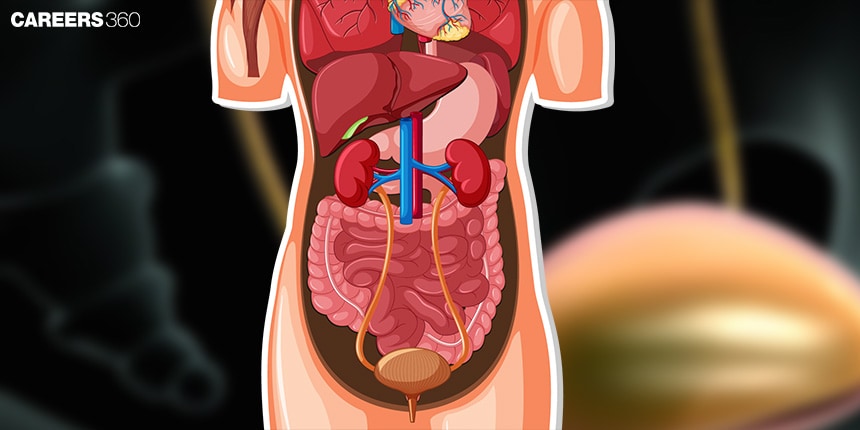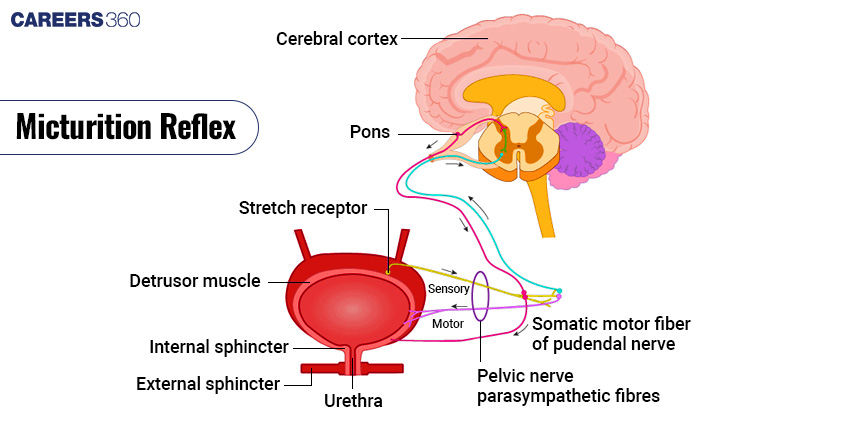Micturition Reflex - Diagram and Process: Definition, Steps, Phases, Disorders
The micturition reflex diagram explains how the body controls urine release from the bladder. This is an important process in the waste removal and maintenance of the fluid and electrolyte balance of the body. As part of the Class 11 chapter Excretory Products and Their Elimination, in biology studying this diagram helps students understand how the brain and nerves work together with the bladder during the micturition process.
NEET 2025: Mock Test Series | Syllabus | High Scoring Topics | PYQs
NEET Important PYQ's Subject wise: Physics | Chemistry | Biology
New: Meet Careers360 B.Tech/NEET Experts in your City | Book your Seat now
- What is the Micturition Reflex?
- Labelled Diagram of Micturition Reflex
- Stages of Micturition
- The Micturition Reflex Process
- Recommended Video on Micturition

What is the Micturition Reflex?
The micturition reflex is how the body is controlled to allow urine to be released from the bladder. When the bladder is filled, the increased volume is detected by stretch receptors in the walls and will signal down the spinal cord and the brain that it requires emptying. Along with the decision to urinate, it can also be initiated by the relaxation of the internal and external sphincters of the urethra along with the contraction of the detrusor muscle of the bladder to allow urine out.
Labelled Diagram of Micturition Reflex

Visual Description: It generally includes the bladder, the urethra, the nerves, and the associated muscles that show an interaction in the process of urination.
Also Read:
- Practice MCQ on Micturition
- Excretory Products and their Elimination
- Human Excretory System
- Locomotion and Movement
Stages of Micturition
Storage Phase: The urine is stored inside the bladder, and the sphincter muscles are contracted not to let it be released.
Voiding Phase: As the levels inside the bladder rise, the nerves get stimulated, and the message is forwarded to the brain. The brain replies that implies the contract of the bladder. The process is to let the urine start flowing through the urethra.
The Micturition Reflex Process
Micturition is the voiding of urine from the urinary bladder.
Filling of the Urinary Bladder
It is a condition where the urinary bladder is filled with urine. When there is a filling of urine in the bladder wall of the urinary bladder is stretched.
Stretch receptors in the urinary bladder sense the rise in its volume and form impulses which are transmitted to the nervous system.
Micturition Reflex
At the point of capacity of the bladder, the stretch receptors send afferent impulses through the pelvic nerve into the spinal.
The stimulus in the stretch receptors produces sensory impulses which are transmitted to the central nervous system.
Afferent Impulses to the Spinal Cord
The sensory impulses as a result of the stretch receptors of the bladder travel via the pelvic nerve and reach the sacral region of the spinal cord.
The impulses that arrive in the bladder enter an integration centre, which is the spinal cord.
Efferent Impulses to the Bladder
Motor efferent impulses are sent from the spinal cord through the pelvic nerve back to the bladder.
The efferent impulses stimulate the detrusor muscle to lead to its contraction.
The Detrusor Muscle Contracts
The contraction of the detrusor muscle increases pressure in the bladder.
This pressure pushes the urine into the urethra and out of the body.
Relaxation of the Internal Urethral Sphincter
There is also an opening of the internal urethral sphincter, which has an involuntary type of control.
The relaxation of the involuntary sphincter will form a passage through which urine can flow from the bladder into the urethra.
Stimulation of Receptors
There shall be a stimulation of the stretch receptors within the urethra when urine flows.
These stretch receptors send further afferent impulses back to the spinal cord, which also serves to reinforce the micturition reflex.
Inhibition of the Pudendal Nerve
Through the relay in the spinal cord, the sensory stimulus can be transmitted further to the brain to issue commands and concomitantly inhibit signals transmitted by the pudendal nerve.
Through this inhibition, it relaxes the external urethral sphincter and releases the urine.
Relaxation of the External Sphincter
Upon relaxation of the external sphincter, the bladder voids urine through the urethra to the external environment.
This can be aided by the voluntary contractions of the musculature of the walls of the abdomen, which increase the intra-abdominal pressure that aids in the micturition.
Self-Regenerative Nature of The Reflex
The micturition reflex is self-renewable in a way that the initial contraction of the bladder causes greater stimulation of the stretch receptors.
This goes on as a continuous process until the bladder has been emptied, and total micturition has been achieved.
Also Read:
| Urine Formation and Osmoregulation | Counter Current Mechanism |
| Dialysis | Disorders of the Excretory System |
| Glomerular Filtrationion Rate | Ammonotelism |
Recommended Video on Micturition
Frequently Asked Questions (FAQs)
The process by which the urinary bladder voids its urine.
The control of micturition is neural, and it is mediated by the micturition reflex, involving responses from the bladder to the brain.
It is found with some frequency that urinary incontinence, urinary retention, and overactive bladder are other common disorders and their treatments primarily include behavioural therapies, medications, and even surgery.
It generally comprises the use of urinalysis, urodynamic studies, ultrasound, and MRI.
New drugs, minimally invasive surgical procedures, and sequences of ongoing clinical trials for the future appear promising.
Also Read
28 Nov'24 08:16 PM
28 Nov'24 06:24 PM
28 Nov'24 12:06 PM
27 Nov'24 04:33 PM
27 Nov'24 02:40 PM
27 Nov'24 12:24 PM